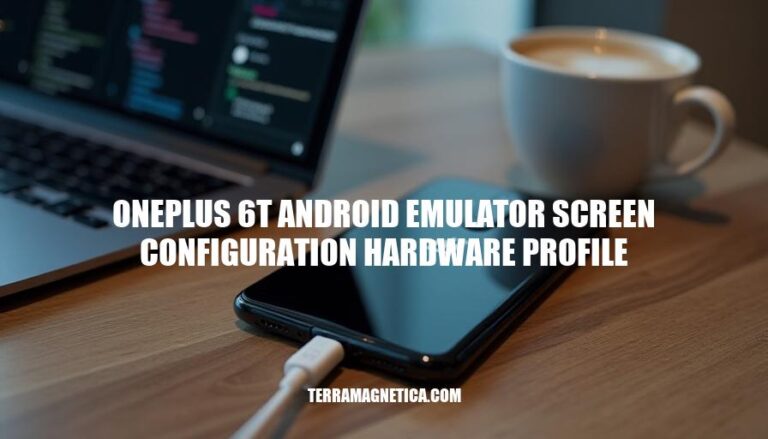Configuring the screen and hardware profile for the OnePlus 6T in an Android emulator is crucial for developers. It allows them to test and optimize their apps in an environment that closely mimics the actual device. This ensures better performance, compatibility, and user experience on the OnePlus 6T, making it an essential step in the development process.
Understanding OnePlus 6T Specifications
Here are the specific hardware specifications of the OnePlus 6T relevant for creating an accurate Android emulator screen configuration hardware profile:
- Display: 6.41 inches, Optic AMOLED, 1080 x 2340 pixels, 19.5:9 ratio, ~402 ppi density.
- Chipset: Qualcomm SDM845 Snapdragon 845 (10 nm).
- CPU: Octa-core (4×2.8 GHz Kryo 385 Gold & 4×1.7 GHz Kryo 385 Silver).
- GPU: Adreno 630.
- RAM: 6GB or 8GB LPDDR4X.
- Storage: 128GB or 256GB UFS 2.1.
- Battery: 3700 mAh, non-removable.
- Dimensions: 157.5 x 74.8 x 8.2 mm.
- Weight: 185 g.
These details should help you set up an accurate emulator profile.
Setting Up Android Emulator
Here’s a step-by-step guide to set up an Android emulator with a screen configuration that matches the OnePlus 6T hardware profile:
-
Open Android Studio:
- Launch Android Studio on your computer.
-
Access AVD Manager:
- Go to
Tools > Device Manager.
-
Create a New Virtual Device:
-
Select Hardware Profile:
- In the
Select Hardware window, choose a device that closely matches the OnePlus 6T. If you don’t find an exact match, select a device with similar specifications and click Next.
-
Configure Hardware Profile:
- Click on
Clone Device to create a custom profile.
- Set the following properties to match the OnePlus 6T:
- Device Name: OnePlus 6T
- Screen Size: 6.41 inches
- Resolution: 1080 x 2340 pixels
- RAM: 6GB or 8GB
- Storage: 128GB or 256GB
- CPU/ABI: x86 or x86_64 (for better performance on most computers)
-
Select System Image:
- Choose a system image that matches the Android version you want to emulate. Click
Next.
-
Verify Configuration:
- Review the AVD configuration and make sure it matches the OnePlus 6T specifications. Click
Finish.
-
Launch the Emulator:
- In the Device Manager, find your newly created AVD and click the
Play button to start the emulator.
Your Android emulator should now be configured to match the OnePlus 6T hardware profile. Enjoy testing your apps!
Configuring Screen Settings
To configure the Android Emulator to reflect the OnePlus 6T hardware profile, follow these steps:
- Open Android Studio: Go to
Tools > Device Manager.
- Create a New Virtual Device: Click on
Create Device.
- Select Hardware: Choose a device that closely matches the OnePlus 6T or click
New Hardware Profile to create a custom one.
- Configure Hardware Profile:
- Device Name: OnePlus 6T
- Screen Size: 6.41 inches
- Resolution: 2340 x 1080 pixels
- Density: 402 dpi
- RAM: 8 GB
- Internal Storage: 128 GB
- Select System Image: Choose a system image that matches the Android version of the OnePlus 6T.
- Finish Configuration: Click
Finish to create the AVD.
This setup will ensure your emulator closely mimics the OnePlus 6T’s display parameters.
Testing and Optimization
Here’s a step-by-step guide:
-
Set Up Android Emulator:
- Open Android Studio.
- Go to Tools > AVD Manager.
- Click Create Virtual Device.
-
Create OnePlus 6T Hardware Profile:
- In the Select Hardware window, click New Hardware Profile.
- Configure the profile to match OnePlus 6T specs:
- Screen Size: 6.41 inches
- Resolution: 1080 x 2340 pixels
- RAM: 8GB
- Storage: 128GB
- Save the profile.
-
Select System Image:
- Choose a system image that matches your target Android version.
- Download if necessary.
-
Configure AVD:
- Assign the OnePlus 6T hardware profile to the AVD.
- Adjust additional settings like Graphics (set to Hardware – GLES 2.0).
-
Launch Emulator:
- Click Finish and launch the emulator.
- Install your app via Run > Run ‘app’.
-
Optimize Performance:
- Enable VT-x in BIOS for better performance.
- Allocate sufficient RAM and CPU cores in AVD settings.
- Use Snapshots for faster startup.
- Monitor performance using Android Profiler in Android Studio.
This setup ensures your app is tested in an environment closely resembling the OnePlus 6T, helping you identify device-specific issues and optimize performance effectively.
Configuring Android Emulator for OnePlus 6T Hardware Profile
To configure an Android emulator to match the OnePlus 6T hardware profile, follow these steps:
- Open Android Studio, access AVD Manager,
- create a new virtual device,
- select hardware that closely matches the OnePlus 6T,
- configure the hardware profile with accurate specifications such as screen size, resolution, RAM, storage, and CPU.
Select a system image that matches the target Android version, verify the configuration, and launch the emulator. This setup ensures accurate emulation for development, allowing developers to test and optimize their apps in an environment closely resembling the OnePlus 6T, which leads to better performance, compatibility, and user experience.


